 Kent Coast Sea Fishing Compendium |
Terminal Rigs |
Essential when choosing a line either for mainline, shock leader or terminal rigs is that the line is of a diameter that will both allow you to cast to the fish, deceive the fish and retrieve them. Diameter, knock strength and a line's durability are the essentials with breaking strains sometimes mythical so choose liner by diameter which can be measured as fact.
The more expensive modern co-polymer lines are superior to the old nylon and monofilaments of the past because they are constructed by uniting the molecules of two or more different compounds adding both "knock strength", suppleness and "amnesia" (lack of memory). Straighten the line in your fingers and it stays straight whereas the older monofilaments retain a curve and are springier. Line technology continues to advance with the recent introduction of fluorocarbon lines and space-age fibres producing ever thinner and stronger lines of all kinds including a diverse range of braids.
Rig making lines are lines made especially for making terminal rigs, it the past any line was used, but now a few firms have selected lines especially for rig building because they offer a lack of coiling memory and are more supple and are also smooth with a consistent diameter and knot strength.
Tapered shock leaders are especially effective where a large leader knot may restrict casting performance, such as when using a fixed spool reel or a multiplier with a level line mechanism. The smallest knot can be tied (double blood knot) and this will run through reel and rings smoothly. If you fish "reel low" with a long rod, ensure that your leaders are long enough.
Line colour matters to anglers in different conditions and situations. Clear lines are favoured in clear water, whilst coloured lines are especially effective when fishing among crowds or with two rods, when lines may become crossed or tangled. Line colour for hook snoods can be a way of telling snoods apart making tangles easier to unravel or just personal preference. The process of colouring line is said to weaken it, but not significantly.
Whilst many anglers base their line choice around breaking strain, line diameter is more important in terms of casting and the reel load because it effects the reel's performance. The lower the diameter the weaker the line, but the further it can be cast. Therefore a compromise of diameter is required to combat conditions and promote casting smoothness and distance. Many manufacturers have varying diameters for the same strength line. Beware of buying low diameter lines that are quoted far stronger than others of the same diameter - stick with diameter as the main criteria and buy yourself a micrometer.
The three main advantages of braid lines are (1) a lower diameter per breaking strain ratio, (2) abrasion resistance and (3) no stretch or memory (they do not curl or coil). They therefore outlast mono, present less opposition to strong tides allowing lighter leads to be used and at the same time show the smallest bites. Micro braids are increasingly popular for both surf casting and lure fishing because of their very low diameter. However, braid can only be used on a fixed spool reel for shore casting because on a multiplier the coils embed into one another and can jam the reel.
Fluorocarbon line is a modern type of monofilament line, made by combining a carbon base (polyvinylidene fluoride) and polymides to produce a line that has the same refractive index as water. This makes it almost invisible which is why it is popular for fishing in clear water. It also sinks more rapidly than standard monos, is slightly stiffer and does not stretch as much. However, it can be prone to fracture under sudden pressure because of its lack of stretch and stiffness.
Two hook, clipped-up rig (aka one-up, one-down rig)
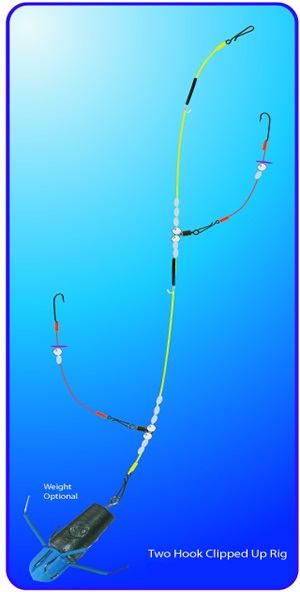
The two hook clipped up rig is the most effective rig for general shore fishing because it spreads two hook baits over a wide area with little risk of them tangling. It is suitable for fishing two baits at medium to long range and uses two bait clips mounted above the anchored swivels which avoids the baits blowing backwards up the hook trace as they would if the bait clips were mounted facing the weight as normal.
It also allows the base hook length to fish tight on the seabed. Fish it when the majority of fish are further out such as on ebb tides, or when conditions are rough and the fish stay in deeper water.
Use this rig for medium to long range fishing throughout the year for spring turbot, flounder, eels, dabs, dogfish, plaice and school bass.
- rig body length: 44 inches
- hook swivel positions: 2 inches, 22 inches
- snood lengths: low 20 inches, top 20 inches
- bait clips: two inverted
In summer exchanging the luminous bead (which catches extra fish when night fishing) for a floating bead, this rig becomes a good shore bream rig.
Add attractor beads in different colours and it picks up summer plaice by day and even gurnards.
In autumn it's the best rig for whiting when fishing the ebb, and takes longer range dabs, flounders, schoolies (bass), codling (cod up to 5lbs in weight), pout, poor cod, rockling and dogfish. And in the winter when the sea is well coloured and rough, this streamlined rig gets baits out to massive distances and picks up mainly coalfish, dabs, flounders, whiting, codling etc.
This rig is favoured over all others for general fishing as it puts a longish hook snood hard on the seabed which is deadly for flatfish, but has the top snood likely to move about more in the surf to target off-the-seabed swimmers such as whiting, coalfish and school bass, especially when casting to medium range and fishing to a fully tight line in deeper water.
This rig is also much simpler to initially tie and set up while fishing than the Loop or Portsmouth rig. The top snood can be made longer and the lower snood shorter, or vice versa, to give the longer snood bait improved presentation in shallow clear water when targeting shy biting fish. The rig is streamlined and uses minimal components aiding casting distance and cutting down on visual impact to the fish when fishing in daylight.
The other advantage with a clipped up rig is that during casting, air pressure is keeping the bait tight on the hook and inside the hook bend maintaining bait presentation, which is something newcomers to rig building often struggle with, even when using bait stops on the hook snoods on more commonly used clipped down rigs.
Clear mono can be substituted for the fluoro carbon. However, fluoro carbon
- lasts longer as a hook snood than mono having a far higher abrasion resistance which protects the snood from rubbing on sand and rougher ground;
- loses less fish such as dogfish, rays and huss when in contact with their teeth should these fish be hooked inadvertently;
- is stiffer and tangles less than mono when fishing inside turbulent surf;
- is less visible to the fish when fishing in calm, clear seas.

Rotten-Bottom Rig
The sea bed around a pier, rocks or kelp ground can snag your end tackle leading to expensive loss of rigs and sinkers.
A method of retrieving your rig and a hooked fish (without loss of a lead weight) is the use of a rotten-bottom or weak-link rig using, as a substitute for the lead weight, one or more hagstones.
A popular choice (but not for long-distance or power casting) is an upturned Gemini Genie clip at the bottom of the main trace with the snood connected to the trace body holding one hook or a Pennell.
The basic rig for fishing from a snaggy pier, over rocks or a weedy bottom, is a single paternoster carrying either one hook or a two-hook Pennell rig.
Components are a size 2/0 oval split ring, Gemini Genie clip, 60lb trace body, 6-10lb line for the weak link, 25lb line for the hook snood, two beads, two crimps, snood swivel, two size 1/0 Kamasan B980 hooks and some rig tubing.
- Tie the oval link to one end of the trace body. Slide on a small piece of rig tube to protect the knot, a crimp, bead, swivel, bead, crimp and another piece of tube. Now tie on the Genie clip, but attach it to the bottom rather than its top eye. Push the rig tube down to protect the knot. Tie on a weak link of 6-10lb line.
- Position the snood swivel. With a 24in snood, place the swivel about 28in up from the Genie link. Now tighten the crimps to fix the position and tie on a length of 25lb snood line to the swivel. Slide on the top hook then tie on the lower hook.
- Tie one or more hagstones of the weight required to the weak link, then slip the loop of the hagstone combo over the Genie link. It can be used for light overhead casts with the sinker releasing from the Genie as it hits the water.
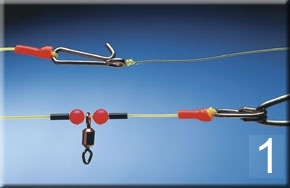 |
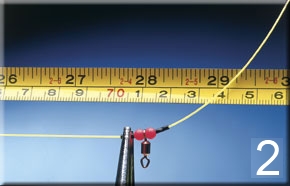 |
"The Angler's Guide: being a new, plain, and complete practical treatise on the art of angling for sea, river, and pond fish; deduced from many years' practice, experience, and observation. To which is added, a treatise on trolling" (1825 - 6th edition) Thomas Frederick Salter at pages 1 - 4, 13 & 14
Chapter I
Preliminary Discourse on Angling - The Choice of Tackle, &c.
"Hope and Patience support the Fisherman."
The Art of Angling consists in taking or catching Fish with a baited hook fastened to a line, with the assistance of a rod; therefore, the first thing requisite to be done by those who wish to perfect themselves in this amusing and delightful art, is to make themselves acquainted with the necessary tackle, and proper baits, as a preliminary step towards carrying their wishes into execution. For this reason I shall commence my Treatise on Angling by pointing out the proper tackle for that purpose, with full directions for choosing the same; also, how to put the rod and line together, to bait the hook, to make paste, ground-bait, &c. and then give instructions in as plain and concise a manner as possible, how to use the angle so as to insure sport in every week or month during the year.
I shall divide the work into three parts, under the denominations of Bottom Fishing, Trolling, or Jack Fishing, and Fly Fishing, with an Appendix: first giving a list of such articles that it is necessary the Angler should provide himself with, illustrated with plates and cuts of the same, under the title of 'Angling Apparatus', it being absolutely necessary that every artist should be furnished with, and made acquainted how to select, and also how to handle his tools, and the materials requisite, before he begins his performance.
The following is a list of articles the Angler should provide himself with …
… Winches for running tackle: prefer those which are made to tie on the rod, or to fix in a groove made for the purpose in the butt thereof, as you can fasten such a winch to any sized joint, which you cannot do with those that have a hoop and screw: on the winch you use when angling for Barbel, Chub, Perch, Carp, and Bream, keep from twenty to thirty yards of fine platted silk line, called running line or tackle, which you pass through the rings on the rod, and join with a slip knot to the gut line. Note - in trolling and bottom fishing the winch should be fastened to the butt of the rod about ten inches from the bottom thereof: in fly fishing about half the distance.
… Note - always keep a piece of shoemaker's wax on a bit of soft leather, some fine silk for tying on a hook, and also some twine, that in case of accident you may be enabled to mend your rod, &c.; to do which see Chap. V.
To fasten the Line to the Rod
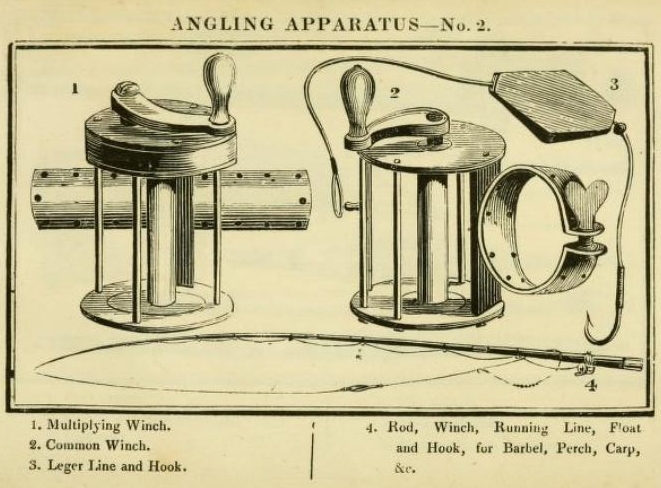
Pass the loop of your line through the ring at the extremity of the top joint of your rod, carry it over the ferril end; then draw your line up to the top again, the loop will then be fast to the ring, and the line will hang from the abovementioned ring. You will then put the joints of your rod together, and the rod and line will be complete. Most experienced Anglers keep about six or eight inches of fine silk line tied to the end of the top joint, and fasten the gut or hair line to the said six or eight inches of silk by a draw loop knot; this is an excellent method, because the ring is apt to chafe gut or hair. When you have a winch on your rod to use running line, after the joints are put together, pass the said running line from the winch through every ring on the rod, and pull about a yard of it through the top ring, and fasten it with a draw loop knot to the line which has the float and hook to it.
See plate of Angling Apparatus, No. 2. Fig. 4. - Note, when you angle with running line for those fish that it is proper to strike the instant you perceive a bite, make a slip knot in the line, and put in the said knot a piece of thin stick, quill, or tough grass, about an inch long, to prevent the line running back on the rod, which it will do, especially if the wind is any way in your front, and by then hanging slack on the rod prevents the hook from fixing firmly in the fish you strike. Always keep your winch unlocked, because, in the hurry of the moment, when you have struck a heavy Fish, and the winch is locked, he generally breaks away before you can give line; to prevent such an occurrence, I use only those winches which are made without locks or stops.
"Prose Halieutics or Ancient and Modern Fish Tattle" (1854) Reverend Charles David Badham M.D. at pages 1, 15, 20, 26, 27 & 28
Chapter I
Ancient and Modern Fishing
Fish being more distinguished for the size of their heads than for the amount of brains lodged in them, and affording consequently an easier capture than either beasts or birds, fell early victims to the crafts and assaults of their arch-enemy, man. Thus, even before the Babylonian captivity, as we read in Habakkuk, he "took them with the angle, catched them with the net, and gathered them in his drag" …
Editor's note: Habakkuk 1:15 - "They take up all of them with the angle, they catch them in their net, and gather them in their drag: therefore they rejoice and are glad." The Book of Habakkuk is the eighth book of the 12 minor prophets of the Hebrew Bible. It is attributed to the prophet Habakkuk, and was probably composed in the late 7th century BC. The Babylonian captivity occurred during the 70 year period between 609 and 539 BC.
Chapter II
Ancient Fishing Tackle
"Show me your tackle and I'll tell you your sport" is a laconic sentence, in which there is a good deal of truth … The heavy-armed hoplitic angler, as he may be called, returns generally from his expedition laden only with disappointment; whereas the true angler, who goes forth light and unencumbered in his accoutrements, secures his object, and returns heavy laden with spoil.
When Oppian enumerates "Horsehair and hooks, the net and tapering reed", as the sum-total of implements used in his day, he mentions, in fact, all that are essential for sport in any day …
… the Izaak Waltons of antiquity condescended to bottom-fishing with lob or caddis worms;
"Or, buried deep, with eggs prolific stored,
Would keep a carrion cat, of gentles the sure hoard."
(Old Angling Book)
We proceed now to mention certain rather abnormal procedures, by which the capture of some species was effected. Aristotle prescribes a very extraordinary bait for the fish salpe - which was a colocynth pill. Eels, on the same authority, are caught by throwing a strong-scented pickling-tub, with a narrow-mouthed net attached to the opening, into a river or pond; these fish, attracted to the spot by the smell, enter, and cannot get out again.
Editor's note: salpe (Sarpa salpa) is a white bream specie of the Sparidae family.
A very singular mode of taking eels is thus described by Ælian:
The artful eeler pitches upon a spot favourable for his purpose at the turn of a stream, and lets down from where he stands, on the high bank, some cubits' length of the intestines of a sheep, which, carried down by the current, is eddied and whirled about, and presently perceived by the eels, one of whom, adventurously gobbling some inches at the nether end, endeavours to drag the whole away. The angler, perceiving this, applies the other end, which is fixed to a long tubular reed serving in lieu of a fishing-rod, to his mouth, and blows through it into the gut. The gut presently swells, and the fish next receiving the air into his mouth, swells too, and being unable to extricate his teeth, is lugged out, adhering to the inflated intestine.
This is a much more ingenious device than the common practice of sniggling for eels with a mop of threaded lob-worms.
Editor's notes:
- Salpe (Sarpa salpa) is a white bream specie of the Sparidae family.
- Ælian, Claudius Aelianus (ca 175 - ca 235) was a Roman author and teacher of rhetoric.
- The cubit is an archaic unit of length based on the length of the forearm from the elbow to the tip of the middle finger.
- A sniggle is a type of fish hook used for catching eels (known as snigs), using the method of sniggling. A typical method of sniggling is to tie a fishing line to the middle of a large needle or fish hook. The needle is then inserted along the body of an earthworm which is used as bait. The needle is then stuck into a slender sniggling pole such as a hazel wand, eight to ten feet long. This is used to insert the bait into promising holes or crannies in which eels tend to lurk. When an eel takes the bait then, after a minute or two, the bait will have been swallowed whole and the line is then pulled to rotate the needle or hook within the body of the eel so snagging and catching it. Eels of two or three pounds weight may be caught by this method but may require a protracted tug of war to pull them from their hole. This provides better sport and amusement than the use of traps or clod-fishing and is a good alternative for the angler when game fish such as trout will not rise. Clod-fishing is a method of catching eels by means of clod or bait of lobworms strung on worsted. The fisher allows this bait to sink to the bottom of the stream and, when he feels an eel tugging, he raises the bait without a jerk from the water, and if successful he will find the eel has its teeth so entangled in the worsted as to be unable to let go.
"Fishing gossip; or, stray leaves from the note-books of several anglers" (1866) H. Cholmondeley-Pennell (editor) at pages 43, 44 & 45 [6]
A Seaside Yarn
I had an opportunity of investigating their sporting operations. The lines, with one exception, were composed of grass cord, which was exceedingly strong, and about the size of ordinary whip-cord; the hooks, of European make, of the description we use for eel-lines; the sinker, a small heavy pebble with a hole in it [4]; the bait, a flat ugly little worm, not unlike a juvenile centipede. There was but one rod, which was owned by the possessor of the exceptional line, who was about as ill-looking an old ruffian, grizzled and mummy-like, as you would find in a long day's march, even through an Indian country - and that is saying a great deal. A very few minutes passed before I had examined his gear, overhauled his catch, patted him on the back, and pronounced him in my own mind a master hand, which during the couple of hours I passed in his company he fully proved himself to be. His line was, I think, of pine-apple fibre, or something very like it, beautifully twisted, very little stouter than salmon-gut, a large even coil of which was placed in a gourd shell at his feet; the sinker, a single buck shot; the hook, the same pattern as the others, but covered with some kind of hard varnish, and sharpened at the point like a needle. The rod was a shoot from a tough shrub, about six feet long, and of very light proportions; this was ingeniously looped by each end to the line, forming, so to speak, a mere continuation of it. On a fish biting, being struck, and making a rush, the stick was instantly cast into the water, where it acted as a float, the line was allowed to run out from the gourd, and the scaly victim dexterously humoured, until pitched high and dry on the sand by the nimble fingers of this ill-favoured but artful old nigger, who managed to catch more than all the rest put together. "So much for fine tackle!" said I. The greater number of fish caught appeared to be a species of barbel, of very fair size and condition.
[4] Editor's Note: an early reference to the use of a hagstone as a sinker.
[6] Editor's Note: Henry Cholmondeley-Pennell (born 1836 the son of Sir Henry and Harriet Emily Pennell) was a British naturalist and editor who published poetry and many volumes on coarse, fly and deep-sea fishing. He writes about the two-hook rig which now bears his name in The Book of the Pike, first published in 1865 (Preface dated Woodlands, Weybridge 1st October 1865). Next year (2015) sees the 100th anniversary of the death of Henry Cholmondeley-Pennell (on 22nd August 1915) and the 150th anniversary of this famous two-hook rig.
"Angling in Salt Water: A Practical Work on Sea Fishing with Rod and Line from the Shore, Piers, Jetties, Rocks and from Boats" (1887) John Bickerdyke at pages 26, 27 & 28
Sundry Tackle &c
… A reel of silk, a reel of thread, and a piece of cobblers' wax in a square patch of leather, should be owned by everyone calling himself an angler. Shoemakers' twist is useful for the larger servings or bindings. Bees' wax is a very good substitute for cobblers' wax, but not so sticky. The varnish for bindings of rods and gut tackle is composed of six parts shellac, eight parts spirits of wine, and two parts gum Benjamin …"
There is always a chance of a big fish when angling in salt water, and it is necessary to have very sound tackle. That purchased is too often unreliable, coming to pieces after a very little use. As long as so many of the girls who do the binding and tying are paid by piece-work, this will probably be the case.
"Hints and Wrinkles on Sea Fishing" (1894) "Ichthyosaurus" (A. Baines & Frederick George Aflalo) at pages 56 to 67
Methods of Sea Fishing
Driftline fishing - I now come to a branch of sea fishing which, while it partly resembles trolling for pike, is in its way unique. In small lakes, there being no tide or current, this fishing can only be practised with live baits, and, indeed, the living sand eel … is the very finest bait for the work in salt water. But the tides and currents are here sufficiently strong to impart an almost lifelike motion to various baits, and to carry an unleaded line far from the boat.
… You simply throw a spinning line out from an anchored boat, substituting in place of the artificial bait some ragworms or a sand eel … My own experience of the sea is that its water is sufficiently buoyant and its currents sufficiently strong to carry out even leaded lines, and the bother is rather to get your driftlines to sink deep enough. For driftlining is by no means surface fishing; and … small pipe-leads have sometimes to be used in order to place the bait at the required depth. Another excellent bait for this fishing, and one especially recommended by the highest authorities, Mr. Wilcocks and others, is the soft green crab. Driftline fishing is especially effective near harbours. I generally put out a couple of these lines when paternostering in the tideway as they want little or no attention, and one simply has to lay down one's rod when a fish is hooked. It is a good plan to make a slip-knot in the line and hitch it loosely over the rowlocks. A fish properly hooked will soon be indicated by the slipping of the knot.
Legering is well known to river fishermen … The bait lies on the sand immediately beneath a leger lead, a flat, coffin-shaped lead that is, with a hole from end to end, or a brass wire twice looped and worked loosely in the lead.
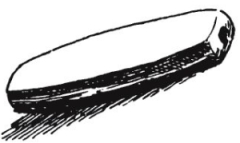 |
 |
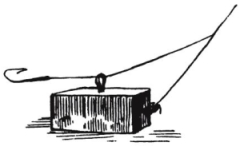 |
| Coffin Lead | Brass Wire Lead | "Clifton" Lead |
Either of these patterns are used in throwing-out from a pier. In the first kind a shot is placed below the lead to keep it in position. But in using a leger immediately beneath a boat, some other device is found necessary, as flat fish bite very delicately. I am indebted for the suggestion depicted in the third figure to a well known amateur fisherman and author who, I believe, had it from a gentleman residing at Clifton. It enables the angler to feel the finest bites.
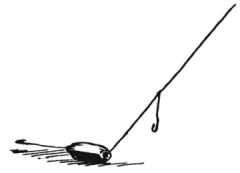
Leger tackle is never used over the rocks. In the actual and original form of this tackle there is but one hook, which lies at the bottom; but practical experience goes to show that another hook placed well above the lead is often effective, as not only do flat fish feed at times a little higher than the ground, but roving whiting, codling and chad are often caught by this second hook. The leger line, whether used in conjunction with a rod or not, is swung out into the deep water and then held until something bites. The fisherman then strikes sharply and hauls in. The baits chiefly used are lugworm and mussel, but pieces of hermit crab and fresh herring are also to be recommended.
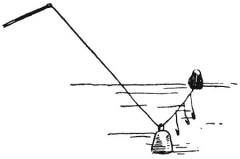
Another modification of the leger, to be used when in pursuit of bass and uncertain of the depth at which they are feeding, enables the angler to search every depth with ease. The arrangement simply consists in a cork being fastened at the extremity of the gut line, which passes freely through a ring let into the lead. Extra line let off the reel enables the cork to rise nearer to the surface and the bait, a dab's head or a slice of mackerel or herring, is taken to a different level.
Paternostering is the most important form of sea fishing, considered from all points of view. There is hardly a fish which I have not at one time or another caught on the paternoster, which can, moreover, be modified to serve the purposes of whiffing, drift and bottom tackle. The paternoster is, in fact, to the sea fisherman, a multum in parvo. [5] It consists, primarily, of several gut-mounted hooks strung on a … line and kept down by a pear-shaped lead. For clear, bright days where there is little current and much sun, nothing can beat this simple form, as the more complicated arrangements of bars and swivels are all too conspicuous. But for the capture of heavier fish on open coasts and in breezy weather, the stronger form of sea paternoster is desirable, the hooks being attached to bars of brass or white metal, which keep them from the main trace.

A new arrangement has recently been patented by a well-known firm, the advantage claimed being greater sensitiveness, and it certainly removes all obstacles between fish and fishermen. The best thing about it, however, is undoubtedly the lead, which can be increased or diminished with great ease. Sometimes, at slack water, an ounce of lead is almost too much; anon, when the tide runs strongly, three-quarters of a pound will hardly hold the ground. This necessity for taking out such a variety of leads has hitherto greatly added to the angler's baggage, but the inventor of this new paternoster has also devised a lead, a really welcome innovation in sea tackle. It is constructed on the principle of those nests of boxes, and each layer can be readily slipped on or off. It is coniform, and therefore rests on the bottom. When paternostering on sandy ground an extra hook looped on to the lead will take some good flat-fish. On rocky ground, however, this hook should be discarded, unless the angler is making a collection of sea-weeds.
The simplest form of paternoster, minus the lead, can be used at a pinch as a driftline or for railing with ragworm for bait.
Besides being useful in searching different depths, this tackle enables the angler to select the best out of several baits, and he will find the tastes of the fish vary most unaccountably from day to day. Unless it was bequeathed to us, as its name would seem to suggest, by those old Thursday anglers, the monks, the origin of this paternoster is a mystery; but it is unquestionably the most useful piece of tackle in the whole catalogue.
One of the most sensitive patterns has been recently brought out by the well-known firm, Hardy Bros., of Alnwick. It enables the angler to feel the tenderest bite and, were it not made of gimp, would enable him also to land the heaviest fish. But gimp is a mistake.
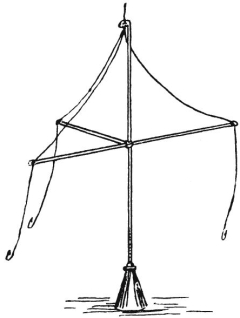 |
 |
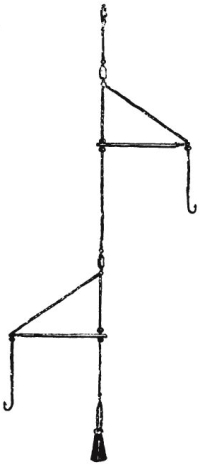 |
Chopstick tackle is also used for bottom fishing but, unless used with a rod, the pier is no place for it at all. It is surprising how people continue flinging such tackle out from pier-heads. I have seen them use it with flies. Its proper position is, however, a vertical one, and if used thus with a hand line from pier landings it is almost certain to get foul of the ironwork.
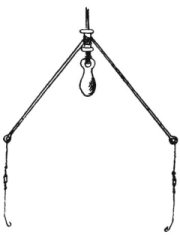
There are various kinds or "rigs" of chopstick. To those who are in the habit of visiting Deal and that coast generally, the Kentish rig will be most familiar. Further west, however, we find other patterns most in vogue. Of these, the principal are the Southampton, in which the crossbar is soldered into the lead, and the Dartmouth, in which the lead hangs at one end of this boom. The Kentish, it will be seen, enables a rapid change of leads; the Dartmouth is particularly useful in a strong tide. The Southampton rig is the clumsiest of all, and as such is yet the most popular among a large class of salts. Mr. Wilcocks has also made us familiar with the revolving boom of the Guernsey rig; while there is the Plymouth form, in which the lead is boat shaped and provided with a curved chopstick. This, like the Kentish and Dartmouth rigs, swings round to the tide. I do not know that the chopstick can be particularly recommended to the amateur. A light one used with the rod is often sufficiently effective, but as a rule it is a heavy unmanageable piece of tackle as ever man's ingenuity devised.
[5] Editor's Note: multum in parvo translated from the Latin "much in little" means a great deal in a small space.
"Sea Fishing (The Badminton Library)" (1895) John Bickerdyke at pages 217, 218, 220, 222, 242 & 243
Sea Fishing from Small Boats
Without much question the best tackle for catching fish on or near the bottom is the paternoster and its various modifications. With the old-fashioned hand line and Kentish or other rig, one dangled about in the water, over and in full sight of the fish, a lump of lead and a cross-bar of metal wire, at the ends of which were attached two pieces of hemp snooding and some rough tinned hooks. With the paternoster the lead lies on the bottom, and the fish see nothing but the gut tackle above it.
In the illustration I have shown the most simple and most generally useful form of paternoster. To it is attached the ordinary pear-shaped lead which may be bought in most tackle shops. How the simple loops are made to which the hook lengths are attached is shown in the illustration opposite. It is a thing anybody can tie up in five minutes out of a couple of yards of gut. Swivels are not always necessary.
The flattened cone lead, shown in the illustration, is rather a favourite of mine. I first saw it at Deal. It offers very little resistance to the water after being lowered, but does not sink so rapidly as the one next to be described.
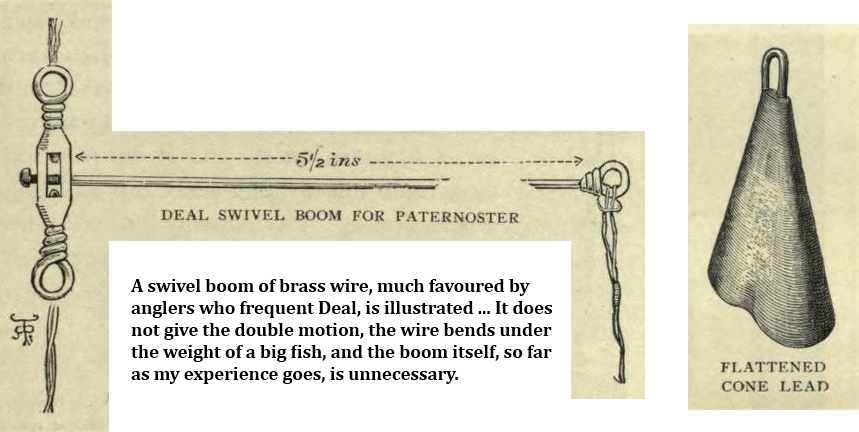
I used to believe that for fishing on the bottom for flat fish the leger was the best form of tackle, but have long ago come to the conclusion that for such purpose there is nothing so good as a modified form of paternoster. For flat fish the lowest hook link should be prolonged, and may bear two or even three hooks at intervals of ten inches. Two I consider quite enough … The lowest hook link may be made three yards or even more in length, and bears half a dozen hooks, when it closely resembles what sailors call a trot, and I think we may call it a "paternoster-trot". It is a deadly tackle for sand dabs, plaice, and other flat fish. Whether the lowest hook link is short or long, it is not advisable to dispense with the second hook link above it, which secures any fish not feeding close to the bottom. I may say that often when angling for flat fish I have caught them on this top hook; they feed off the bottom more often than people suppose.
These various forms of the paternoster will, I think, suffice to catch fish on or near the bottom in any water round our coasts.
With regard to hand lines, the most ancient form, and that still most commonly used, consists of a lead and a spreader, from the two ends of which dangle snoodings with hooks. There are several varieties of this tackle; the best of them is perhaps the Kentish rig, of which an improved form, invented by Mr. Hearder, is illustrated on this page. A loop of line, which the maker would be well advised to make at least five inches in length, holds the lead. On it is a piece of brass piping with rolled edges, and on the piping is the twist of wire the ends of which are prolonged and form the spreaders. By pushing up the piping (which saves the line from friction) the lead is easily unlooped and a heavier or lighter one put in its place. To each end of the spreader should be fixed a small swivel, and to this the snood, which may be about a yard or less in length, and when possible of gut, should be attached.
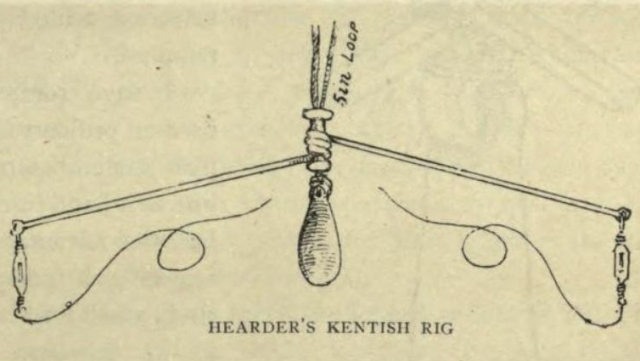
The construction of a true Kentish rig is shown in the second illustration. There the spreaders are of whalebone, and they and the lead are held together by a strip of leather. Additional leads, indicated by the dotted lines, are added when required.
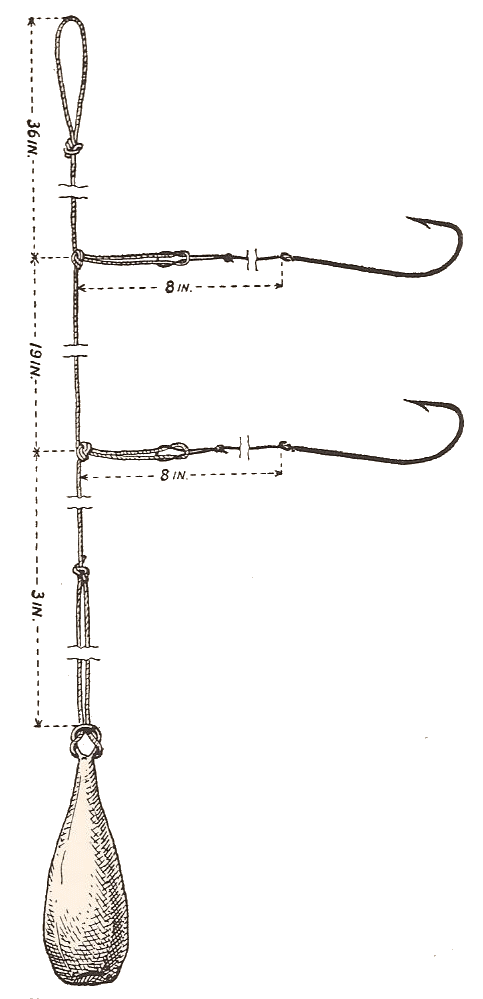 |
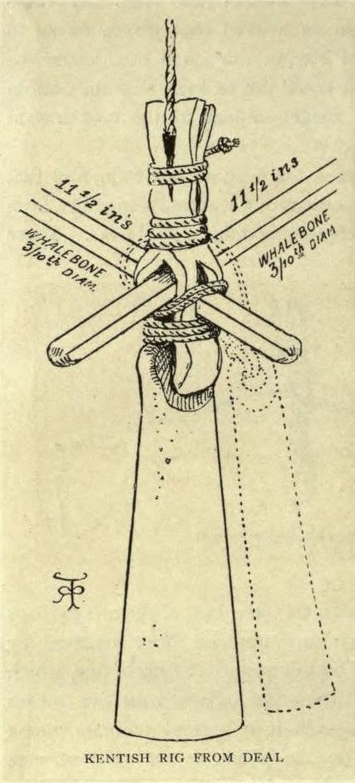 |
"Sea Fish" (1898) Frederick George Aflalo at pages vi & 4
A paternoster or leger, made up and baited as recommended by Mr. Wilcocks in his Sea Fisherman [1], would, in the right place, take fish as well today as thirty years ago …
… so great is the abundance of fish in the sea and so fierce are their appetites, that a paternoster, or other suitable tackle … baited with fresh meat or fish, will usually take fish of some kind in deep water.
[1] "The Sea Fisherman" (1865) James Carrall Wilcocks

"Practical Letters to Young Sea Fishers" (1898) John Bickerdyke at pages 134 to 138, 171 & 172
Bottom Fishing from the Shore
After trying many and various forms of paternoster and ledger, the conclusion I have come to is that, for casting out from a shelving shore among a shoal of codling, there is no better tackle than the most simple form of paternoster … that is to say, a length of gut with a couple of loops in it, to which the hook links are attached, each bearing a single hook. Two hooks are usually enough, but three can be used, and a good general size of hook for the purpose is that shown in the illustration. For baits there is nothing better than lug worms, mussels, or live shrimp … No booms are required on this paternoster, they are absolutely unnecessary for this kind of fishing. The weight of the lead will entirely depend on the strength of the current running close inshore. Where it is very strong a half-pound weight may be necessary, but this is rather an excessive weight. From two to three ounces is usually sufficient …
It is not always that very long casts are needed, in fact, unless there is heavy ground swell breaking on the shore, the codling come very close in to feed off the shrimps and other inconsiderable trifles which are stirred up by the surf. Some people find a great difficulty in keeping a mussel on the hook when making a long cast. I have not experienced this myself, and it is probably owing to their not understanding the proper way of placing a mussel on the hook, described on page 106. One way of overcoming the difficulty is to wind round the mussel a fleck of sheep's wool. Cotton wool will also do. Sometimes mussels are tied on with a piece of worsted, but this is rather a clumsy arrangement.
For fishing on the bottom for bass and grey mullet, the ledger is, perhaps, to be preferred to the paternoster, owing to the yard of gut next the hook lying on the bottom and being out of sight of the fish. The fish, too, can go off with the bait a little distance without having to drag the lead after it. This may seem a small point, but it is one on which large bass and mullet are sometimes unduly sensitive.
The construction of the ledger for casting from the shore is shown in the illustration (below) … For the sake of simplicity I make the lead work on the running line, so that the tackle consists of nothing more than a length of gut, a hook, a lead, with the usual rod, line, and reel.
The weight of the ledger lead, like that of the paternoster lead, must depend entirely on the strength of the tide and force of the waves, and should be the lightest possible lead that will hold bottom, and will vary from one to four ounces. In very exceptional circumstances a heavier lead than this may be required …
Bottom Fishing from Boats
I have not spoken of the ledger … because I do not find it often required in sea fishing from boats. The paternoster, with a single hook link bearing two or more hooks, answers almost every purpose, telling the bites as easily as any ledger that was ever made. But for those who prefer a ledger for boat work, I can recommend the tackle much favoured by my friend Mr. Aflalo. It simply consists of an ordinary freshwater conical plummet, having the usual brass ring at the top. The running line is passed through this ring, and a small piece of match tied in (clove hitch …) near the end of it. To the end of the line is then tied about a yard and a half of gut, on which may be one or two hooks. When a fish takes the bait the line is drawn through the brass ring at the top of the plummet, much the same as in freshwater fishing, when it is drawn through a hole in a bullet. Of course, these little plummets are not of much use except where the water is shallow, or where there is little tide. The ordinary ledger is illustrated (below) and explained (above) …

"Dover as a Sea-Angling Centre" (1900) Deputy Surgeon-General Charles Thomas Paske at pages 88 & 89
Chapter X
Paternoster
This ranks as A1 for bottom fishing and is, indeed, a very formidable, seductive weapon owing to the fact of presenting a dainty worm or other bait at three different depths - near the bottom, another 14 inches higher up, and a third the same distance above that. From the swivels which intervene between the sections, wire booms 3½ inches in length project at right angles, and from each of these hang down a short snood, hook and bait. When the lead is attached these booms stand out describing a circle in the water when under the influence of currents. This motion adds, of course, to its effectiveness. Until very recently the objection to the Paternoster lay in a fish pulling the line side-ways instead of direct; now however, I notice that Farlow and Co. have succeeded in constructing one fitted with "Kirby's Patent Straight-Pull Booms" which obviates this, thus rendering the action as in ordinary … to add to its deadliness a ledger can be attached when fishing on a sandy bottom. When fish are well on the feed it is not an uncommon thing to catch three at a time and of different sorts - a pouting, codling and silver whiting - when fishing over a bed of rocks.
"An Angler's Year " (1904) Charles S. Patterson at pages 16 to 20
Chapter I
On Tackle
Sea Angling Tackle
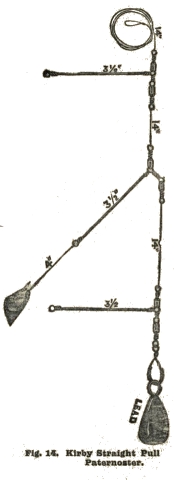
The old fashioned paternoster also was greatly improved, finer material being substituted for the thick, twisted gut so much in vogue; while the rigid booms were replaced by appliances giving a straight pull between the hooked fish and the rod point, such as Clements' ledger boom and various direct-pull paternoster booms, of which the Diamond boom (Figs. 12 and 13) has in the hands of the author proved most satisfactory. This last-mentioned little appliance has as its chief advantage its simplicity and shortness, a long boom for boat fishing being usually a mistake, save and except at dead slack water when long booms and snoods are of undoubted value. The author is at present working on a long boom paternoster which is released and gives a straight pull when the fish bites. (Fig. 14.) Of other forms, that sold by Farlow's as Kirby's Straight Pull is very good, as is also the treble swivelled arrangement of Mr. Jephcott, of Margate, described later in this book.
With all sea fishing tackle the difficulty has been found to be that if fish are not feeding freely they feel the check of the lead before the bait is properly in their mouths, and are inclined to spit the lure out as soon as they feel any resistance. As was so ably pointed out by Mr. A. W. Parker, in his lecture before the British Sea Anglers' Society in 1898, no form of ledger, in any depth of water or run of current, will permit of the line running through the lead. Several forms of boom invented by clever sea-anglers were also for the same reason proved to be useless for the purpose for which they had been invented (namely, that of allowing the main line to run through them when the fish pulled, without the lead being moved). Mr. Parker's own ingenious pendulum boom to a certain extent allowed the fish to run with the bait without feeling a check, but at the same time possessed the defect that until the fish had run to the end of his tether no indication of a bite was conveyed to the angler. Mr. Parker's argument, moreover, overlooked the fact that a greater pendulum already existed, composed of the rod-point, the line, and the lead; and he does not appear to have remarked that hardly any check was caused to a feeding fish by the lead, if such were properly adjusted, as such a load requires but a minimum pull to drag it down tide off the bottom.
In the department of bottom tackle proper, the old Kentish rig of boom has, during the last year or two, been applied to rods, and several attempts have been made to get some strong, light form which could be feasily carried and quickly rigged up. The first successful form was invented by Mr. Clements in 1897, and consists of a treble arrangement of arms having a lead link suspended below, and a swivel on a traveller horse above, giving a direct pull on either of the lateral arms should a larger fish take the bait.
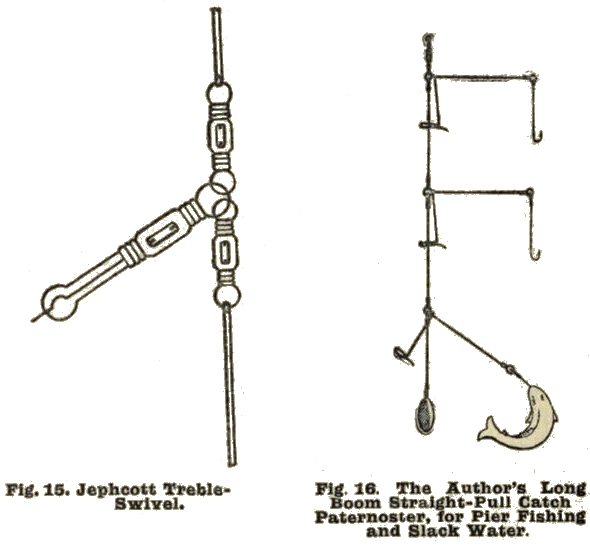
This, the writer can say from several years' experience, is an admirable rig for fishing for cod and whiting, and with the lateral arms rigged with long snoods (4ft. - 6ft.) is perhaps the best arrangement in existence for sea bream. It, however, possesses one great disadvantage, namely, its want of portability. This has been remedied in a new collapsible boom (Fig. 40) invented by Mr. T. B. Bates, a well-known member of the British Sea Anglers Society, and a sea rod-fisher of several years' standing. The full description of this rig would probably prove wearisome, but a brief sketch will convey a general idea of the apparatus. The material out of which the boom can be made is either German silver, hardened brass, or, better still, steel wire double-coppered. There are two arms, each terminating in a swivel, and made of an inner and outer piece of wire so that the length of each arm can be regulated at will, so that, when not in use, the apparatus can be reduced to one-half its length fully extended. When rigged up - a matter of less than half a minute - the boom has quite the spread of the usual Kentish rig as used on fishermen's hand-lines, and when collapsed goes comfortably in the breast-pocket. It will be interesting to note in the future whether this tackle will be as successful as the Kentish rig and hand-line have been in previous years in the capture of big cod; for it allows what no ledger or paternoster tackle (except that next mentioned) efficiently permits, namely, that the cod to rove about for some distance uptide with the bait before feeling a check, an advantage - the writer is convinced - in the capture of these bottom-feeding, slow-moving fish.
Another form of tackle which has appeared in various modifications is known variously under different names. It consists practically of two short cross-pieces made fast in the middle, to each end of which is attached a hook link. The main body of the paternoster is made either of jointed German silver wire or of gut; the arms may be either straight or bent; and the lower cross-piece may be either close to the bottom or raised six to twelve inches.
The best known patterns are those sold by Carter & Co. as Pine Tackle Nos. 1 and 2 (after Mr. David Pine, of Maidstone) (Fig. 17.). Many anglers have had great success with this tackle, notably Mr. Pine, who fishes regularly with this rig in Pegwell Bay during the late autumn and winter.
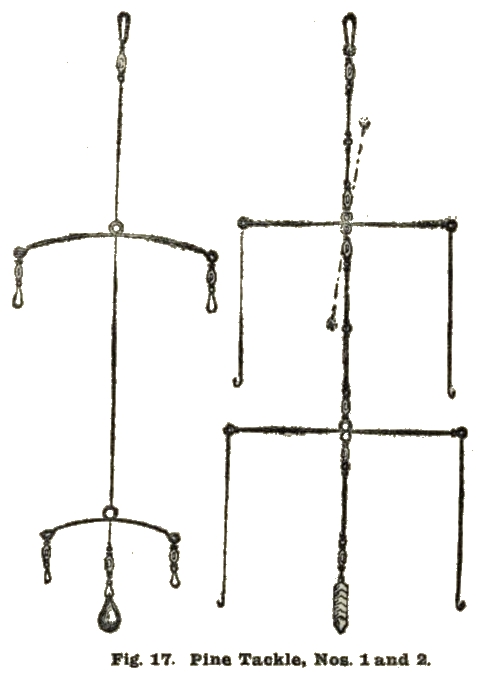
This tackle gives a straight pull on the hooked fish and is specially useful for slack water, as the baits are kept free from entanglement. Some anglers fish with the upper snoods longest; personally, however, if fishing for cod and whiting, I should prefer the lower cross-piece close to the bottom and the snoods of the lower hooks twice as long as those ofthe hooks above. In a heavy run of tide such tackle should not be used, as the cross-pieces offer too much resistance to the current.
"Sea Fishing" (1911) Charles Owen Minchin at pages 272 to 275
Chapter XVIII
Tackle for Angling
… Leads required will be the "Banker's lead" for very heavy work; bottom-leads, of which there are innumerable patterns, according to the nature of the bottom. Of these one of the most useful is the "grip lead" for use on muddy bottom or soft sands: it is in the form of a flattened ring with numerous projecting knobs on each side. The ordinary pear-shaped lead will not roll about and travel too much if it is flattened out a trifle with a few blows of a hammer.
Leads are liable to "hang up" in the crannies of rocky ground, but this annoyance can be obviated to some extent by mounting the lead on the principle of a scowed anchor, which can be done by having a little brass ring fixed into the large end; the trace is tied to this ring and only bound with a few turns of pack-thread to the usual ring set into the smaller end. If the lead jams in a crevice, a slight pluck on the line breaks the pack-thread and transfers the pull from the small end (where the jam usually is) to the large end, so that the lead has a chance of being pulled out.
There is a good deal of judgment in selecting the particular shape of lead to suit the fishing; for instance, when one fishes from a boat for cod or codling it is desirable to "work the ground over" and this is best done with a round or pear-shaped lead which always travels a bit, but if casting from a pier across the tide a lead such as the "grip" or one of a flat diamond-shape will keep its place much better, weight for weight.
"Slip-leads" are needed for trailing and whiffing, and an adjustable rosary of several small "pipe-leads" for drifting a bait among pollack or bream from an anchored boat.
If the ground is rocky or weedy a good clearing-ring, made of lead or cast-iron and carried on a hand-line, will save many losses of tackle. It should be made with a fine slot, cut diagonally, to slip it over the rod-line.
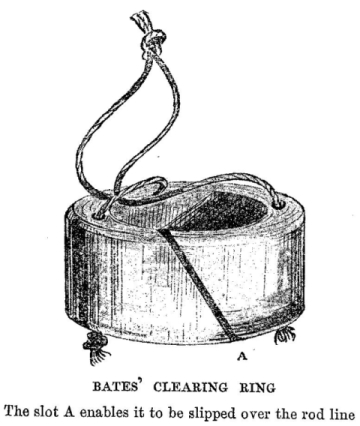
… An old two-pronged fork, well filed down, makes a splendid disgorger, and a discarded sword-bayonet, such as are sold cheap to make up trophies, is an admirable conclusive argument if there should be occasion to wrangle in the bottom of the boat with an obstinate conger.
"Approach to Angling in Fresh and Sea-Water" (1950) E. Marshall-Hardy and Lieut. N. Vaughan Olver, R.N.V.S.R. at pages 191 & 192
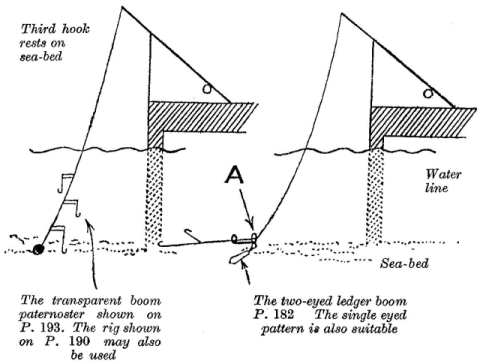
Section IV: Sea Fishing from Jetty, Pier or Shore
Chapter III
Fishing on a Sandy Shore
The Tackles
… In passing, it is interesting to speculate on the origin of the name paternoster as applied to fishing tackle. I like to think that when monks fished for their Friday meal, they used a multi-hooked tackle much on this principle, with baits suspended equidistant from one another on their lines; and that these reminded them of the paternoster beads on a rosary. It may not be so, but the idea is pleasant.
The second and perhaps more sensitive (to bites) tackle for fishing over sand from shore level is the ledger (or paternoster trot). Why this rig is called a ledger is a matter in dispute. The Waverley Modern English Dictionary, however, says: "Probably from the medieval English leggen after medieval Dutch ligger (Dutch legger), that which lies in a place".
"Competition Sea Angling" (1970) Bruce McMillen at page 52
4. Methods
A 'floating' sinker
This is a hint which could well save you losing many sinkers and terminal tackle, and it could also prevent the loss of a great number of fish.
When shore fishing over rocks and heavily weeded areas, your terminal tackle will frequently become snagged and, as a result, it may be lost. In order to minimise this possibility, dispense with the lead sinker and tie a flat pebble in its place [2]. Choose one about the same weight as your normal sinker and place it inside a piece of nylon stocking, mutton cloth or stockinette and secure the bag to the trace by a piece of weak line. If the 'sinker' becomes caught up in either weed or rock the weaker line will break or the pebble will tear from its flimsy container. However, if the weight does not snag, once it is on the move it will come skimming along on the surface and thus clear all intervening obstacles.
After all, pebbles cost nothing and there are usually plenty lying about on the beach. Lead sinkers are not only relatively expensive but no matter how flat they may be they will not come to the surface in the manner of a flat pebble. This idea has now become quite a common practice in rocky and heavily weeded areas such as the Menai Straits.
And finally on the subject of losing weights, never place them on soft wet sand. You will be amazed at the speed at which they disappear !
[2] Editor's Note: alternatively, use one or more hagstones, as necessary.
"Successful Sea Angling" (1971) David Carl Forbes at page 41
The following is a very rough guide to hook sizes for different species:
| Bass | 1/0 - 3/0 |
| Bream | 4, 6 or 8 |
| Cod | 4/0 - 8/0 |
| Conger | 4/0 - 10/0 |
| Common Skate | 6/0 - 10/0 |
| Thornback | 3/0 - 5/0 |
| Ling | 4/0 - 6/0 |
| Pollack | 2/0 - 4/0 |
| Tope | 6/0 - 10/0 |
| Whiting | 1 - 4 |
| Mullet | 12 - 6 (freshwater scale) |
| Wrasse | 2, 4 or 6 |
| Flounder | 2 - 4 |
| Plaice | 1 |
| Turbot | 6 - 8 |
"The Guinness Guide to Saltwater Angling: Light tackle technique for British waters" (1977) Brian Harris at pages 49 to 53
3 How to use the tackle: basic techniques
… Prime considerations for choice of terminal rigs for shore fishing are that they should cast well and present the bait properly without any tendency to tangle. This means that the lead weight, whenever possible, must be at the end of the line when the tackle is suspended from the rod tip and must lead the tackle in flight.
The fixed nylon paternoster serves perfectly well when it is necessary to have the gear in a state that will cast a long way and remain tangle-free while it is fishing. This applies in situations where fish sought are unlikely to be put off, or are able to drop the baited hook if they do become alarmed by any tension in the nylon linking them to the main line and the anchored lead. This rig is fine for cod, for bass in wild surf, and for some flounder fishing. The running version is excellent for quieter waters where the fish takes the bait, swims away with it and is brought up - bass among the rocks in shallow water or in estuaries, for conger or tope from the shore, and for smooth-hounds. The fixed version can have a short snood or hook link - as little as 4 in (10 cm) - or a long one - as long as 6 ft (1.8 m). If the hook is kept sharp - as all hooks should be - the fish takes the bait, swims away with it and is brought up suddenly by the anchored lead. The point of the hook catches in the skin of the mouth, the fish panics, lunges away, and the hook sinks deeper. The angler sees the rod tip movement or feels the pull on the line if he is holding the rod, and pulls home the barb.
However, there are times when fish are not quite so ready to be fooled. A bass hunting at leisure among the weedy rocks for crabs and small fish, for example, will often inspect a bait for a while before gently picking it up and tasting and feeling it. Should the fish at this stage feel any untoward resistance it is likely to drop the bait. But with the running paternoster the hook link may be pulled freely through the eye of the swivel for several feet, depending on the slackness of the line from lead to rod tip, and the fish is likely to swallow the bait as it begins to move away. The signal of the bite is seen or felt and the strike made in the normal way. Not only bass but tope, smooth-hounds, rays and conger are usually best attacked with the running paternoster.
Many anglers no doubt use a normal running leger, the lead on a link-swivel or (worse) on a Clements boom or a Kilmore clip, and are wondering why the running paternoster is being praised while the straight leger, with the lead running directly on the main line and not on a dropper lead link, is being ignored. Well, the reason is that the running paternoster not only casts with the lead in front of the rest of the rig, but it also permits the fish more freedom to take the bait gently. Small swivels are less obvious than Clements booms and the like; they are also much cheaper !
Simplicity is the key to good terminal tackle. If something does not do a useful job on the rig, then it should not be used.
With the fixed nylon paternoster the length of snood is usually best kept to less than 1 ft (30.48 cm) where the distance between its point of attachment on the standing part of the line is about 2 ft; only rarely is it necessary to change this proportion. And generally speaking, similar proportions of hook link and lead link serve well with the running version.
There are many leads made for surf fishing, and most of them are unnecessary. There is no good reason nowadays to use any shape other than the elongated pear or bomb shape, with free-swinging anchor wires or without. If the water being fished is not too boisterous the ordinary bomb lead will be fine, as it will if you want to allow the tackle slowly to rove about the seabed. If, however, you want to cast far and hold the bait in one position then use an anchored lead known as a breakaway lead.
This lead has been largely instrumental in helping British sea anglers who wish to use lighter tackle to do so, because its adjustable anchor wires collapse at a light pull and trail inoperative behind as the lead is wound in along the bottom. The old type of wired lead has its wires set at a right angle to the lead's axis. moulded in, so that they have to be pulled from the seabed by brute force, and once pulled free often hook in again on the way in. These leads, which, incredibly, many anglers still use, demand heavy lines and strong rods.
The breakaway or break-out lead was perfected by two Angling Magazine contributors, Ian Gillespie and Nigel Forrest, following a campaign by that publication for more sporting tackle in the sea. Many weird systems were produced by readers and contributors, including Don Neish, the well known caster and tackle shop owner, finally culminating in two basic types. Both have anchor wires swinging freely through the nose, but on one type the wires are held in the anchoring position by an elastic band; the other has them held by tension in the wires pressing them into slits in a nylon collar fitted round the lead, or by beads on the wire which fit into recesses moulded in the lead.
No sporting shore angler should be without such leads of one type or the other. All work extremely well.
So, on an Atlantic surf beach, for bass or whatever, the fixed nylon paternoster with a 2 - 3 oz (56.6 - 85 g) breakaway lead is cast out, the hook carrying lug, razorfish or clam, and the slack line taken up. The light rod is held and bites are felt for by hand, through the rod or through the line.
If it's tope from the shore, or big stingrays, maybe, then the heavier rod might be used. For tope or conger the running paternoster rig is made up with a wire trace connecting the hook to the link swivel at the end of the casting leader. The bait, such as mackerel or small pouting is cast way out, the breakaway lead pulled into the bottom, and the rod set up on a rest so that its tip is high. The reel is set so that a taking fish can pull line off against a slight check and so give audible warning as well as the visual one of the rod tip's movements.
Again, when fishing among rocky ground, for bass or conger, the running paternoster is used. For bass the rod is held so that bites of a shy nature may be detected and the correct action taken; for conger the rod is rested, as for tope or rays.
These methods are basic and are at present only being touched upon. They will be dealt with again later.
Another shore fishing situation is the pier, stone breakwater, bridge, rocky promontory or similar seaward projection. Strangely, though it would seem that such places would offer better chances of good fishing than the shoreline itself, such is seldom the case. Such projections are usually in areas of high population or with industry, so that pollution and disturbance weigh against the right habitat for good fish. However, some of the above mentioned spots do produce good fishing for cod, bass, rays, mullet, mackerel, conger, flounders, shads and others on our sporting list. One of the big advantages of a good pier or projection is that not only can legering be tried but float fishing, spinning and driftlining as well.
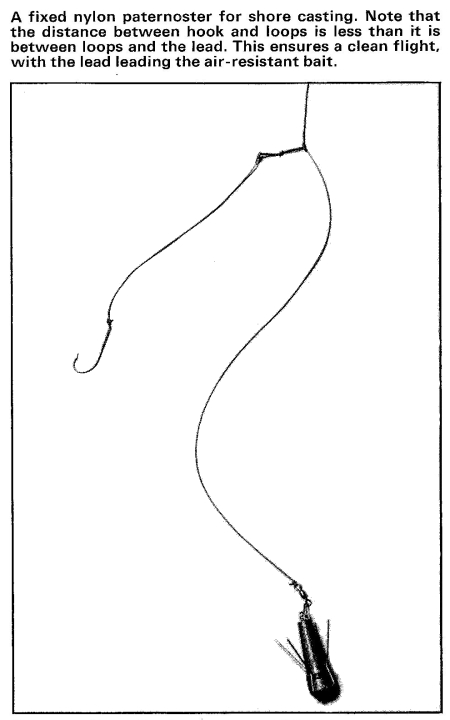 |
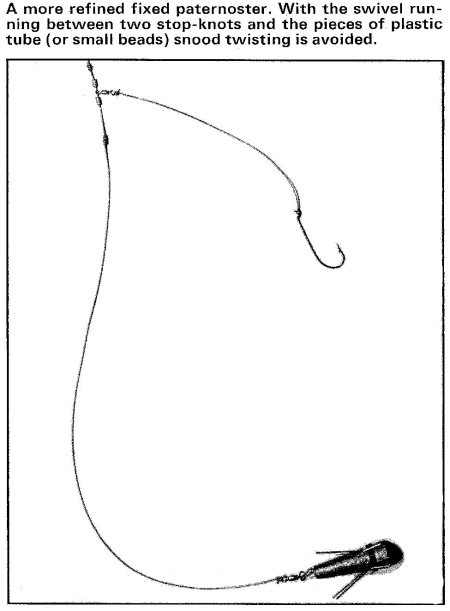 |
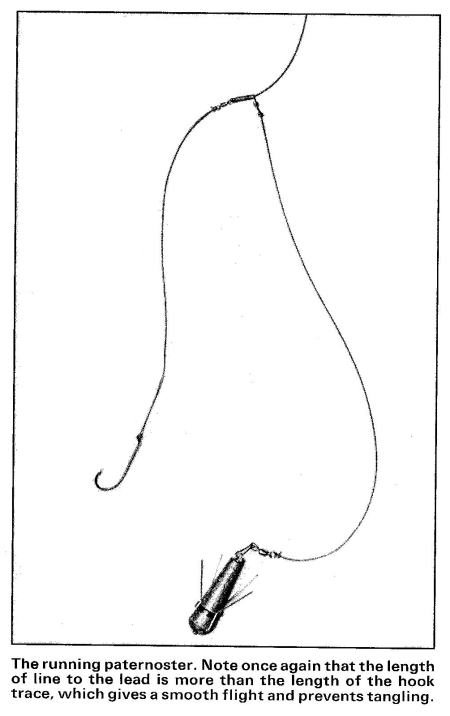 |
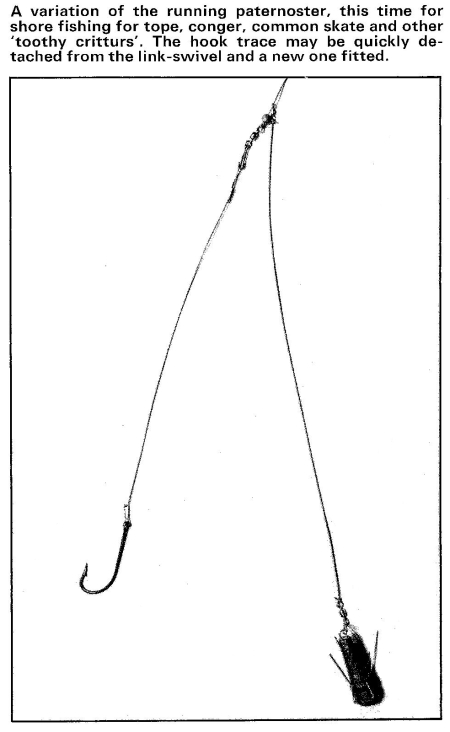 |
"Fisherman's Handbook" The Marshall Cavendish Volume 2, Part 35 (1978) Ken Whitehead at pages 978 to 980
Tackle
Sea Booms
To the expert, the array of terminal tackle displayed in the sea section of a tackle shop is fascinating; but for the beginner or inexperienced angler that same array can be a nightmare of odd-shaped wire lengths. Terminal tackle for sea fishing has certainly undergone many changes in recent years, and the mixing of old and new, coupled with the barriers created when various items are identified by different names in different parts of the country, often leads to misunderstandings. Nevertheless, if the angler remembers his basic fish lore, selecting the right tackle is common sense.
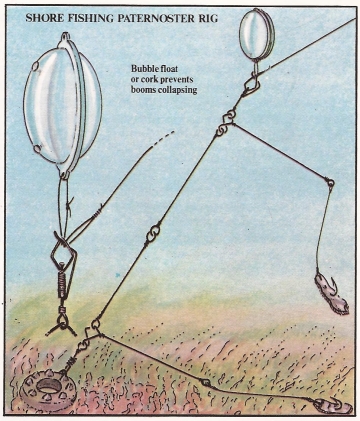
Importance of swivels
Most sea tackle is designed for quick release, so that lead or reel line can be altered with the minimum of disturbance and, to counter the twisting action of the sea, swivels should be incorporated wherever possible. Because there is a tendency for hooks and line to twine together, wire, in the form of a boom, is used to keep the bait away from the reel line, and as snag-free as possible. The size of the boom and its position depend on the depth at which the bait will be presented, which in turn depends on where the fish sought are believed to be feeding.
The most popular item of end tackle is probably the paternoster. This is an arrangement of wire arms that will hold hooks at right-angles to the line both on and just above the sea bed, making it ideal for use over uneven ground. There are two and three-boomed varieties, the booms being spread out and held by the terminal weight, which is attached by a corkscrew link. The material used for paternosters is usually brass, but stainless steel, giving a firmer, more subtle arrangement, has found favour with many anglers; especially in the early part of the season when the water is clear.
Efficiency with the metal paternoster is at its best when the line is held vertically, with the rod tip above it, and this, in the vast majority of cases, means fishing from a boat. When the rig is used for shore fishing, the lack of angle between line and the bottom will cause the booms to collapse. To prevent this happening, some anglers fix a large bubble float or piece of cork above the buckle swivel where the reel line is attached, which lifts the rig into a vertical position.
French booms
The ready-made paternoster presents the hook only 2ft or so above the bottom. Where it is required to hold a bait well above the sea bed, French booms should be used. These triangular wire frames can be fastened to the line by two or three twists around the central column and over the centre lug. This simple attachment means that they can be raised or lowered with ease to any depth, and that more than the normal two or three booms can be attached. But there is a disadvantage with French booms in that a heavy fish will slide them down the line, which leads to some stretching and distortion if monofilament is used. This can also weaken the line.
A single-trace boom can be used either as a running or a fixed ledger and is especially useful if a long trace is to be allowed to flow with the tide. In its fixed state it will allow several feet of monofilament to lie away from the line without tangling. But it has a specific use over rocky ground in its running form, used with a length of low b.s. line with which to attach the weight. Should a snag occur, then the finer line will part, allowing the main tackle to be retrieved. The wide angle between the points of the boom helps to keep both bait and trace from tangling around the main line.
There are several booms specially for ledgering, the best known being the Kilmore boom. In its simple form this consists of a loop of wire leading to a swivel and lead attachment. The loop through which the line is passed can be plain, or fitted with an inner ring of porcelain, or harder-wearing metal. The latter are the better choice, for plain wire in constant use causes line damage. If the porcelain-lined model is used, take care to mount a bead stop between the eye and trace swivel, otherwise a hard knock will cause the brittle lining to fracture. A major disadvantage of the Kilmore boom is that the lead hangs from the bottom of the boom, causing the trace which hangs past it to tangle, either when the rig is descending to the bottom, or between rebaiting and casting, when the lead naturally swings freely.
The Clements boom
The Clements boom is designed to prevent such tangling. The wire boom has a large eye twisted in either end, and from the end of one of these loops hangs the lead attachment. The reel line is threaded through the loops so that the lead attachment hangs farthest away from the trace. This gives a cantilever effect to the boom, making it stand at right-angles to the line and holding the trace well away from the lead. Again, there are several different types of lining fitted into the eyes of the boom, but it pays to use one that will help to counteract wear.
A long Irace with a Clements boom means that the stop would have to be fastened 8 ft or so from the end hook, which could lead to problems when landing a lish. There is a release Clements boom on the market which has a small inner cylinder along the body, through which the line is passed. With the cylinder pressed against the line the boom will stop in place, but once reeled tightly against the rod tip, the cylinder will free itself, allowing the whole rig to slide down to the end of the trace. The fish can then be played to the surface and landed.
There are many other sea rigs available, and it interesting to note that in many of them, plastic is now being used as the principal material. But most of the new arrivals are merely variations on the basic themes described above.
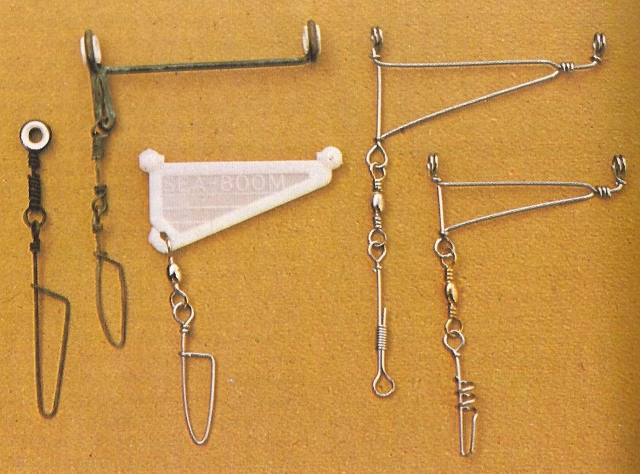
The single-eyed Kilmore boom, and variants on the double-eyed Clements boom, designed to prevent line and trace from tangling.
|
"Sea Angling: Kent to Cornwall" (1990) Mel Russ & Alan Yates at pages 15 & 16 The most successful terminal rig used in Kent is the simple paternoster, with up to three hooks spaced equally up the body. Variations include a longer snood on the lower hook in the form of a flowing trace from the same line as your leader, in most cases 50lb to 60lb breaking strain. Hook snoods should be of 25lb breaking strain. It is a mistake to go for lighter snoods as they spin in the tide or quickly get damaged wafting about on the seabed. The make-up of the rig is dependent on what the angler is fishing for. A single 3/0 or 4/0 hook rig is often preferred for cod and bass, while multi-hook rigs, with up to three size 1 to 4 hooks, are best for flatfish, whiting and pouting. A single bait rig for bass or cod can incorporate a Pennell twin hook system, which is especially effective for fishing large peeler crab or squid baits. Rigs made up with strong swivels stopped by telephone wire, beads or stop knots allow for adjustment of snood positions. Use only quality swivels on your rigs - Berkley is one of the best. |
"Operation Sea Angler: The Second Wave" (2013) Mike Ladle & Steve Pitts at pages 195 to 197
Hooks and Weights: the vital links
Weights and Movement
What are the disadvantages of a lead armed with wire prongs ? … the greatest disadvantage of all … is the one for which these gadgets were intended. They stop the tackle from wandering about on the seabed. One of the most useful tactics in the sea angling repertoire is to keep the bait on the move. By searching the sea bottom with a rolling leger or by slowly retrieving after each cast, it is often possible to bring your tackle to the attention of more fish. It also helps to locate the position of hot spots or 'dustbins' on any stretch of the seabed. Lastly, by imparting movement to the bait you may be able to induce certain species to take. Few brill, turbot, pollack, cod or bass would prefer a dead, motionless bait if presented with the alternative of a lively attractor.
It is possible to obtain different degrees of movement by varying the size and shape of the lead on your tackle. A small lead will be more easily mobile than a large one and a flat-sided pyramid will hold better than a rounded bomb or bullet. So next time you go down to the beach don't automatically reach for your grip lead. Consider whether you would be better to let your bait search the seabed … stones with holes [3] snag less and have some advantages.
[3] Editor's Note: 'stones with holes' are called hagstones.
… under-weighted tackle is much more versatile … free-lining can be very productive.
Surface-feeding fish … may take a buoyant bait delivered on light spinning tackle; casting distance can be increased by using a bubble-float, a self-cocking float or a controller … Alternatively, denser or bulkier (but still buoyant) lures can be used.
Even the lightest lures (mackerel strip, tiny spoons or plugs) can be fished at or near the surface by using conventional fly tackle …
Mid-water feeders can be tempted from anywhere between the surface and seabed by a number of approaches. These include: suspending a bait under a float; tight-lining to a weight with the hook on a dropper above the bed; using a sinker bait or lure which is then kept up by winding in or lifting with the rod either on spinning or fly tackle; or using a diving vane, either separate from the bait (paravane) or as part of the bait or lure (plug lip).
Generally, what limits distance is casting capability, but by skilful use of water currents or wind it is sometimes possible to fish floats, buoyany baits or drift line tackle at surprisingly long range. In parts of the Mediterranean, anglers tether their lines to little rafts with paper sails and drift the baits long distances to find fish …
For bottom feeders it is a matter of waiting until the bait settles on the seabed after casting out. The settling process can be speeded up by adding weight, with or without grips. Again, distances are usually limited by casting potential, but in a few situations they can be increased by reducing the amount of weight and drifting the tackle away on tidal currents.
Clearly we have the technology to tempt fish in almost any combination of conditions, wind and weather. Why, then, do many sea anglers restrict themselves to heavy leger or paternoster tactics ? … this depends on where and when you fish but … anglers have shown conclusively that conventional bottom fishing is often much less productive than methods tailored to catch a particular species. The question is just how many kinds of sea fish actually pick their food up from the seabed ? Probably most species will 'grub about' at times, but a great many of them prefer their menu on the move. Fishing on the drop, sink and draw or just slow retrieve are simply ways of giving the bait life. Often you read about the advantages of fishing a long flowing trace and the movement it allows a bait. Even when the baited hook is hard on the bottom a slow retrieve will attract fish.
Shore Angling Rigs
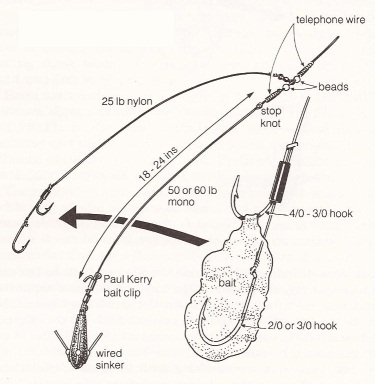 |
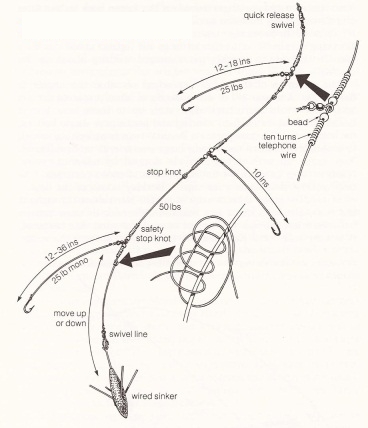 |
| Pennell Hook Rig | Standard Beach Rig |
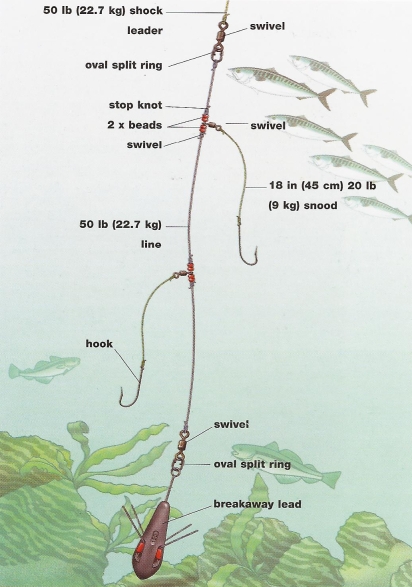 |
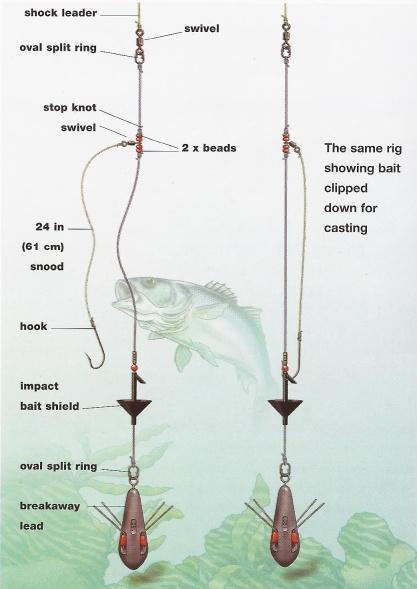 |
| Two-hook Paternoster: a popular rig to use from the shore when beach or pier fishing. Having two hooks set on the rig at a short distance apart gives the angler a chance to try two different types of bait at the same time. If one of the baits proves to be more popular than the other, it is a simple matter of changing the one that has failed. This rig is widely used when fishing for shoal fish such as whiting. | One-hook Distance Rig: often used by the distance caster in search of cod and smooth hounds. The one-hook rig can be clipped down so it is able to be cast a considerable distance. Used in a strong tide the baited hook will sway in the tide and attract the fish. A bait shield is fitted to protect the bait on the cast. |
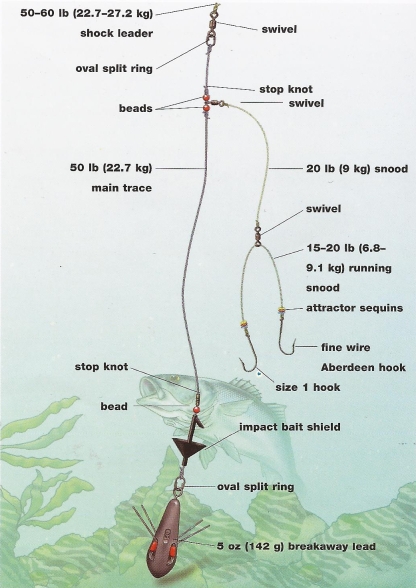 |
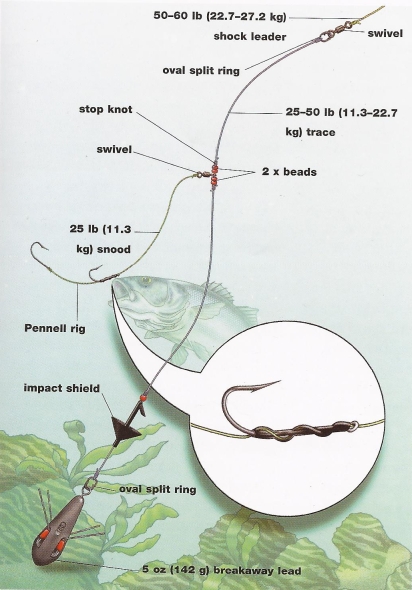 |
| Wishbone Rig: a firm favourite of the cod angler who is fishing at distance from the shore in a strong tide. The two-hook rig is able to run free, through a swivel and provides a "bolt hooking" effect when either of the hooks is taken by a large fish. The addition of a bait shield will allow delicate baits like lugworm to be cast great distances with minimal damage to the bait. | The Pennell Rig: a well-used rig when fishing for bigger species like bass, dogfish, cod and smooth hounds. The addition of the second hook on the snood allows the use of a bigger bait. Whole calamari squid can be mounted up to imitate a live bait when bass fishing. For dogfish, a side of mackerel can be mounted on both hooks, offering a large treat to tempt a take. |
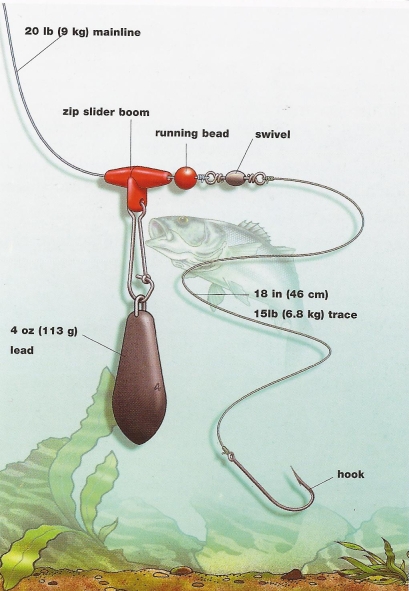 |
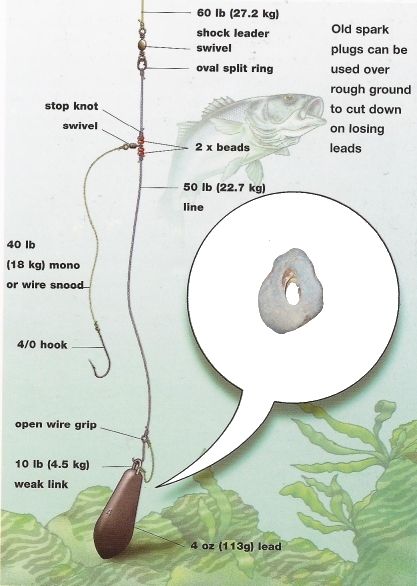 |
| Running Leger Rig: used when fishing over light shingle or sand. It is popular among sea anglers who are targeting flatfish, such as plaice or flounder. Using a small sliding boom with a quick-release clip on it, allows the weight to be changed very quickly without having to break down the tackle. The small rubber bead on the trace below the boom acts as a shock absorber. | Rough-ground Rig: used when fishing over rough and rocky ground. It is widely used when fishing for conger, tope, rays and dogfish. One or more hagstones can be used as a weight to keep losses of tackle down to a minimum. A rotten bottom link is used to enable the angler to jettison the hagstone(s) and break free from a snag without losing a hooked fish. |